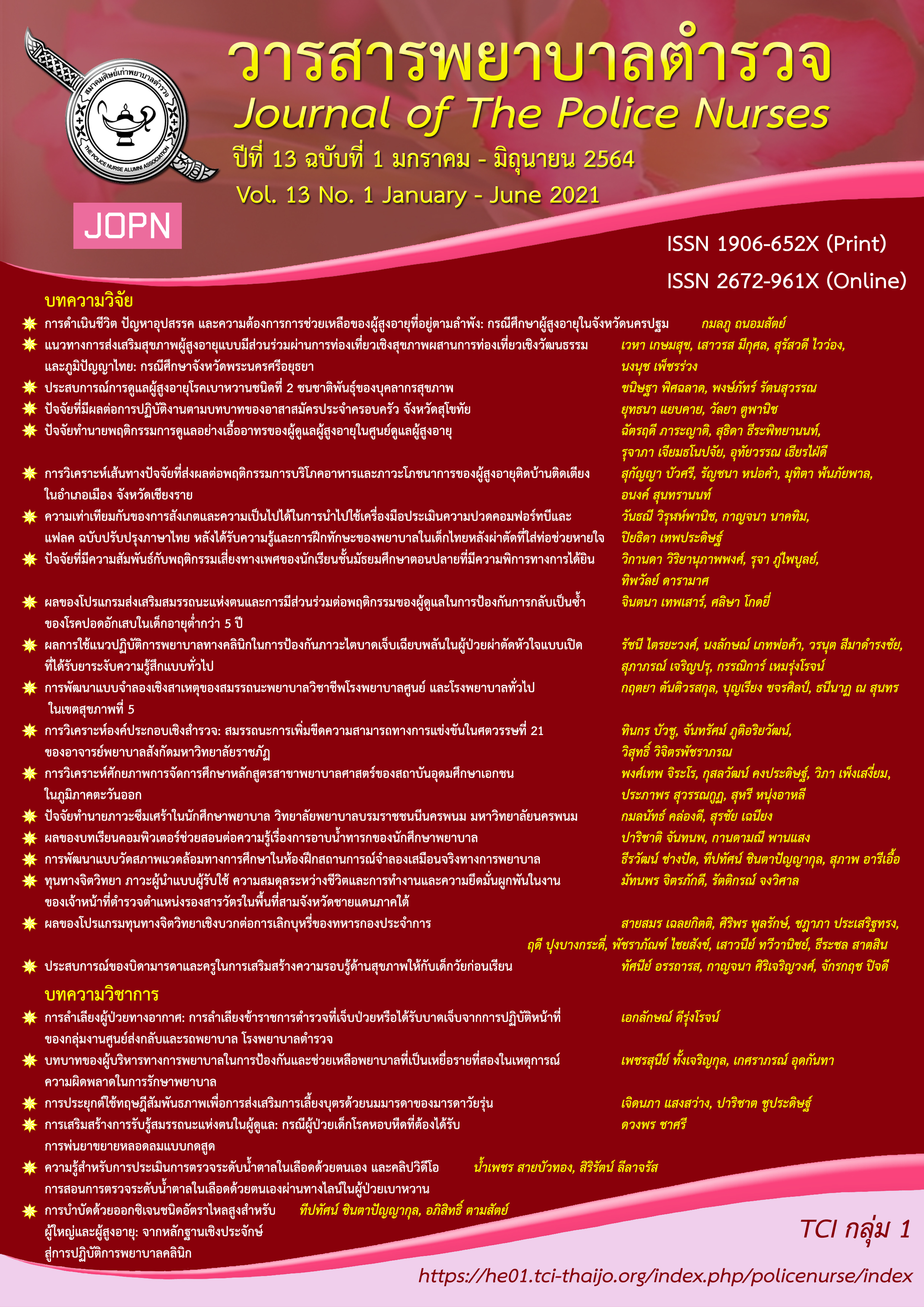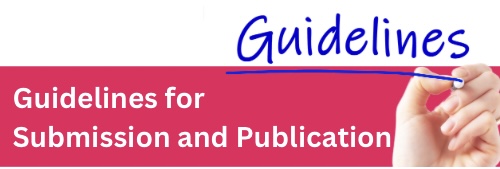HIGH FLOW NASAL CANNULA OXYGEN FOR ADULTS AND ELDERS: FROM EVIDENCE TO CLINICAL NURSING PRACTICE
Keywords:
oxygen therapy, high flow nasal cannula, Corona virus disease 2019Abstract
High-flow nasal cannula oxygen (HFNC) is one of the treatments for patients with hypoxic respiratory failure to prevent unplanned intubation. HFNC is medical equipment providing adjustable oxygenation percentage to 100% of required oxygen-air concentration with a maximum flow rate of 60 liters per minute. The HFNC provides optimum humidity and temperature to the patients leading to effective releasing mucus or respiratory tract secretions. It also increases the amount of oxygen in the body resulting in convenient and comfortable airway clearance therapy. Evidently, the HFNC diminishes the intubation rate in adult and elderly patients with pathological problems of the respiratory system. Currently, HFNC is a preferable medicinal remedy in tertiary hospital settings treating patients with coronavirus disease 2019 (COVID-19) who have a respiratory failure with moderate to severe hypoxia. Therefore, empirical knowledge, the understanding of HFNC’s mechanisms, indications, contraindications, and the guideline set up are essential for nurses to enhance the translation of evidence-based practice into nursing care for promoting efficient and effective quality of care.
Downloads
References
Abrard, S., Jean, L., Rineau, E., Dupré, P., Léger, M., & Lasocki, S. (2021). Safety of changes in the use of noninvasive ventilation and high flow oxygen therapy on reintubation in a surgical intensive care unit: A retrospective cohort study. PloS one, 16(3), e0249035.
Annunziata, A., Coppola, A., Carannante, N., Simioli, F., Lanza, M., Di Micco, P., & Fiorentino, G. (2021). Home management of patients with moderate or severe respiratory failure secondary to COVID-19, using remote monitoring and oxygen with or without HFNC. Pathogens, 10(4), 413.
Ari, A., & Moody, G. B. (2021). How to deliver aerosolized medications through high flow nasal cannula safely and effectively in the era of COVID-19 and beyond: A narrative review. Canadian Journal of Respiratory Therapy, 57, 22–25.
Baldomero, A. K., Melzer, A., Greer, N., Majeski, B. N., MacDonald, R., & Wilt, T. J. (2020). Effectiveness and harms of high-flow nasal oxygen (HFNO) for acute respiratory failure: A systematic review protocol. BMJ open, 10(2), e034956.
Bentley, S. K., Iavicoli, L., Cherkas, D., Lane, R., Wang, E., Atienza, M., . . . Kessler, S. (2020). Guidance and patient instructions for proning and repositioning of awake, non-intubated COVID‐19 patients. Academic Emergency Medicine, 27(8), 787-791.
Bonnet, N., Martin, O., Boubaya, M., Levy, V., Ebstein, N., Karoubi, P., . . . Cohen, Y. (2021). High flow nasal oxygen therapy to avoid invasive mechanical ventilation in SARS-CoV-2 pneumonia: a retrospective study. Annals of intensive care, 11(1), 1-9.
Chaudhuri, D., Granton, D., Wang, D. X., Burns, K. E., Helviz,Y., Einav, S., . . . Rochwerg, B. (2020). High flow nasal cannula in the immediate postoperative period: A systematic review and meta- analysis. Chest, 158(5), 1934–1946.
Drake, M. G. (2018). High flow nasal cannula oxygen in adults: An evidence-based assessment. Annals of the American Thoracic Society, 15(2), 145–155.
Fisher & Paykel Healthcare. (2019). Optiflow™+ nasal cannula user instructions. Retrieved from https://resources.fphcare.com/content/optiflow-nasal-cannula-user-instructions-ui-185048241.pdf
Fisher & Paykel Healthcare. (2020). AIRVO 2: High flow system, setup guide. Retrieved from http://www.fphcare.com/ip
Frat, J. P., Coudroy, R., Marjanovic, N., & Thille, A. W. (2017). High-flow nasal oxygen therapy and noninvasive ventilation in the management of acute hypoxemic respiratory failure. Annals of Translational Medicine, 5(14), 297.
Lee, C. C., Mankodi, D., Shaharyar, S., Ravindranathan, S., Danckers, M., Herscovici, P., . . . Ferrer, G. (2016). High flow nasal cannula versus conventional oxygen therapy and non-invasive ventilation in adults with acute hypoxemic respiratory failure: A systematic review. Respiratory Medicine, 121, 100–108.
Lee, J. H., Rehder, K. J., Williford, L., Cheifetz, I. M., & Turner, D. A. (2013). Use of high flow nasal cannula in critically ill infants, children, and adults: A critical review of the literature. Intensive Care Medicine, 39(2), 247–257.
Leong, L. B., Ming, N. W., & Feng, L. W. (2019). High flow nasal cannula oxygen versus noninvasive ventilation in adult acute respiratory failure: A systematic review of randomized-controlled trials. European Journal of Emergency medicine, 26(1), 9–18.
Li, J., Jing, G., & Scott, J. B. (2020). Year in review 2019: High-flow nasal cannula oxygen therapy for adult subjects. Respiratory Care, 65(4), 545–557.
Makdee, O., Monsomboon, A., Surabenjawong, U., Praphruetkit, N., Chaisirin, W., Chakorn, T., . . . Nakornchai, T. (2017). High-flow nasal cannula versus conventional oxygen therapy in emergency department patients with cardiogenic pulmonary edema: A Randomized controlled trial. Annals of Emergency Medicine, 70(4), 465–472.
Mauri, T., Wang, Y. M., Dalla Corte, F., Corcione, N., Spinelli, E., & Pesenti, A. (2019). Nasal high flow: Physiology, efficacy and safety in the acute care setting, a narrative review. Open Access Emergency Medicine, 11, 109–120.
Mellado-Artigas, R., Ferreyro, B. L., Angriman, F., Hernández-Sanz, M., Arruti, E., Torres, A., . . . Ferrando, C. (2021). High-flow nasal oxygen in patients with COVID-19-associated acute respiratory failure. Critical Care, 25(1), 58.
Monro-Somerville, T., Sim, M., Ruddy, J., Vilas, M., & Gillies, M. A. (2017). The effect of high-flow nasal cannula oxygen therapy on mortality and intubation rate in acute respiratory failure: A systematic review and meta-analysis. Critical Care Medicine, 45(4), e449–e456.
Nishimura, M. (2015). High-flow nasal cannula oxygen therapy in adults. Journal of Intensive Care, 3(1), 15.
Nishimura, M. (2016). High-flow nasal cannula oxygen therapy in adults: Physiological benefits, indication, clinical benefits, and adverse effects. Respiratory Care, 61(4), 529–541.
Parke, R., McGuinness, S., Dixon, R., & Jull, A. (2013). Open-label, phase II study of routine high-flow nasal oxygen therapy in cardiac surgical patients. British Journal of Anaesthesia, 111(6), 925–931.
Pornsirirat, T., & Tongyoo, S. (2020). Nursing care for adult patients with acute hypoxic respiratory failure receiving high flow nasal cannula. Siriraj Medical Bulletin, 13(1), 60-68.
Raoof, S., Nava, S., Carpati, C., & Hill, N. S. (2020). High-flow, noninvasive ventilation and awake (non intubation) proning in patients with Coronavirus disease 2019 with respiratory failure. Chest, 158(5), 1992–2002.
Ricard, J. D., Roca, O., Lemiale, V., Corley, A., Braunlich, J., Jones, P., . . . Hernandez, G. (2020). Use of nasal high flow oxygen during acute respiratory failure. Intensive Care Medicine, 46(12), 2238–2247.
Roca, O., Caralt, B., Messika, J., Samper, M., Sztrymf, B., Hernández, G., . . . Ricard, J. D. (2019). An index combining respiratory rate and oxygenation to predict outcome of nasal high-flow therapy. American Journal of Respiratory and Critical Care Medicine, 199(11), 1368–1376.
Rodriguez, M., Thille, A. W., Boissier, F., Veinstein, A., Chatellier, D., Robert, R., . . . Coudroy, R. (2019). Predictors of successful separation from high-flow nasal oxygen therapy in patients with acute respiratory failure: A retrospective monocenter study. Annals of Intensive Care, 9(1), 101.
Vega, M. L., & Pisani, L. (2021). Nasal high flow oxygen in acute respiratory failure. Pulmonology, 27(3), 240-247.
World Health Organization. (2021). COVID-19 clinical management living guidance. Geneva: World Health Organization.
Xu, Z., Li, Y., Zhou, J., Li, X., Huang, Y., Liu, X., . . . Zhang, H. (2018). High-flow nasal cannula in adults with acute respiratory failure and after extubation: A systematic review and meta-analysis. Respiratory Research, 19(1), 202.
Downloads
Published
How to Cite
Issue
Section
License
ผลงานที่ได้ตีพิมพ์แล้วจะเป็นลิขสิทธิ์ของวารสารพยาบาลตำรวจ















